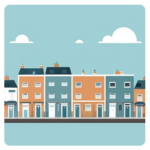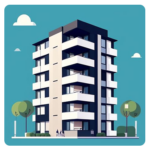

See how Wakefield’s districts have performed across key property categories each year, supported by comparisons with towns in the wider area.
You’ll also learn whether demand is evenly spread across neighbourhoods – or focused in select high-growth zones.
House Prices > Wakefield
| Year | Average Price | Transactions |
|---|---|---|
| 2025 (proj.) | £242,100 | 2,887 |
| 2024 | £234,400 | 2,084 |
| 2023 | £226,900 | 2,478 |
| 2022 | £231,200 | 3,221 |
| 2021 | £221,200 | 3,671 |
| 2020 | £204,200 | 2,582 |
| 2019 | £196,100 | 3,019 |
| 2018 | £193,800 | 3,151 |
Think prices in Wakefield are stuck in the slow lane? Think again. Wakefield’s market has proven to be quietly robust, even while whispers of downturns circle other northern cities. If you cast your eyes back to 2018, you’ll spot steady, even resilient growth in average home values—punctuated by ripples rather than wild swings. For those curious about what fuels these trends, our Simple Valuation Guide for Wakefield puts the spotlight on local factors that shape the numbers year after year.
If you’re eyeing Wakefield with a north-of-England budget, you’re not adrift on open waters. Wakefield’s price trajectory reveals a market capable of weathering squalls and bouncing back elegantly. What it all means? Buyers and sellers alike can find confidence. This isn’t a short-lived surge or a bubble riding the wind, but a region building value steadily, with rare moments of correction instead of collapse.

Avg. Property Price: 348,800
Avg. Size of Property
1,302 sq/ft
Avg. Cost Per Sq/ft
£277 sq/ft
Total transactions
1,323 (since 2021)

Avg. Property Price: 204,200
Avg. Size of Property
921 sq/ft
Avg. Cost Per Sq/ft
£225 sq/ft
Total transactions
1,823 (since 2021)

Avg. Property Price: 151,900
Avg. Size of Property
869 sq/ft
Avg. Cost Per Sq/ft
£180 sq/ft
Total transactions
1,559 (since 2021)

Avg. Property Price: 107,500
Avg. Size of Property
642 sq/ft
Avg. Cost Per Sq/ft
£168 sq/ft
Total transactions
218 (since 2021)
The property market in Wakefield is simmering like a proper Sunday stew, heating up gradually rather than boiling over. Yet behind those neat averages, there’s a patchwork of striking differences depending on which set of keys you’re reaching for. Prices, square footage, and cost per square foot diverge sharply across the property mix, raising some genuine questions about what you’re really getting for your cash.
Start with detached homes: if you’ve got your eye on one of these, you’re looking at a higher average price and a spacious footprint. But is this premium warranted or is it just habit that sends local aspirations in this direction? While these houses evoke images of broad Yorkshire skies and big gardens, they still command less per square foot than some smaller, more compact options. That’s curious, especially considering the relentless talk of land scarcity and rising build costs. Are buyers genuinely prioritising space or do we just think that’s what they want? Then again, an impressive number of transactions suggests this traditional preference is holding strong—at least for now.
By contrast, flats occupy a very different niche. Their lower average price and modest size might tick the boxes for anyone looking for something manageable or dipping a cautious toe into the property market. Their much lower cost per square foot signals one thing: the market sees less inherent value in dense, vertical living. Is this just a provincial thing or a signal of wider buyer sentiment? Fewer completed sales make you wonder whether flats are simply an afterthought—or whether the Wakefield buyer is still searching for that elusive patch of grass.
Semi-detached properties offer middle-ground, and judging by the high number of transactions, they’re Wakefield’s workhorse. These homes bridge the gap: not sprawling like detached houses, nor as compact (and sometimes unloved) as flats. The costs here—both total and per square foot—feel palatable for families and upgraders who want enough space but also crave manageable bills.
Terraced homes paint a similar story, though perhaps with an extra slice of nostalgia for Wakefield’s colliery towns and terraced rows. Their lower entry price and steady sales volume suggest they’re most attractive for those pursuing value, even if the cost per square foot doesn’t break records. We’ve noticed that, for all the noise about “best investment picks,” the real competition here is for affordability and proximity to amenities.
Still questioning what’s driving these distinct trends? Check our full breakdown on What Impacts House Prices in Wakefield? if you want more than surface numbers.
| District | Avg Price (£) | Transactions |
|---|---|---|
| WF1 | £205,800 | 5,264 |
| WF2 | £221,100 | 5,497 |
| WF3 | £215,500 | 4,701 |
| WF4 | £216,800 | 4,883 |
Property prices in Wakefield have ballooned recently, fizzing up like kids chasing soap bubbles along the banks of the Calder. So much for the tired cliché that Wakefield is just Leeds’ overlooked little brother. In truth, the districts here are wildly different, with their own quirks, energy, and pace — and the gap between the so-called best and “lesser” districts is noticeably slimmer than most expect.
Those who claim “location is everything” should take a closer look at how close-knit the price bands are. WF1, WF2, WF3 and WF4 all huddle within a tight price window, leaving no room for prestige postcodes to run away with the crown. In other northern cities, you see wild swings from one end of town to the other. Not here. Wakefield’s market stubbornly refuses to play drama queen.
But before you call it boring — look at how energetic the transaction volumes remain. Properties are changing hands in the thousands, not just dribs and drabs. This isn’t some sleepy commuter bolt-hole. It’s a town in motion, with buyers and sellers hustling for position. If you think that speaks to market weakness, you might want to check out Wakefield vs Other Cities: A Property Price Comparison and see what intense competition really looks like up north.
Don’t get fooled by averages either. Averages in Wakefield are almost devious, smoothing out pockets of leafy calm and pockets of lively, boisterous family demand. Look a little closer and you’ll catch some districts attracting aspirational movers, while others are perfect for shrewd, pragmatic buyers after real value.
The mainstream headline always says “Wakefield is affordable.” Clever buyers, though, see that this is a city of steady value, low volatility, and subtle growth. Maybe that’s not flashy, but it’s remarkably resilient.
Just a quick reminder: the numbers you see focus on price and transaction averages only.
Property sizes and cost per square foot have not been factored in, so some patterns could be blurred. For a full district breakdown, head over to our blog. Thanks for stopping by.
| City | Avg Price (£) | Transactions |
|---|---|---|
| Ossett | £198,400 | 2,177 |
| Normanton | £172,200 | 2,310 |
| Dewsbury | £159,500 | 4,074 |
| Batley | £157,300 | 2,647 |
| Heckmondwike | £143,900 | 1,070 |
| Castleford | £166,900 | 6,001 |
| Mirfield | £222,200 | 2,210 |
| Liversedge | £180,200 | 1,615 |
| Pontefract | £177,100 | 7,190 |
| Leeds | £218,800 | 52,586 |
This part of Wakefield is experiencing a lively property market, especially when held up against its neighbours. Some areas nearby are steaming ahead with quick sales, while others seem to have their market in second gear. For strategic buyers, that means choice, value, and plenty of angles to consider.
Now, roll a stone out towards Dewsbury or Batley and you find pockets where prices drop sharply but the market is bustling. The number of transactions in these locations suggests constant movement - homes come up and get snapped up quickly, perhaps by first-time buyers, or landlords on the hunt for steady rental stock. That kind of churn indicates plenty of flexibility for negotiation, but you’ll want to move as fast as the local footy team attacking down the wing if a bargain appears.
What all this means is that Wakefield's market is neither sedate nor overly volatile. There are choices at every budget, whether you relish the adrenaline of a busy town like Dewsbury, or prefer the measured approach of Mirfield or Liversedge.
The property scene in Wakefield is a rollercoaster ride - thrilling for some, stomach-churning for others. For strategic buyers, knowing where each area sits on the map makes all the difference.
Note that the figures above present average prices and number of transactions, not detailed metrics.
They do not adjust for differences in property size or cost per square foot. For a closer view, head over to our blog. Thank you.
Through a clever fusion of respected data and powerful valuation algorithms, we deliver impressively refined property insights, all the way down to individual streets. Our system reworks EPC and Land Registry records (making sharp adjustments where needed) to remove noise and show true patterns.
Our site uses cookies. By using this site, you agree to the Privacy Policy and Terms of Use.